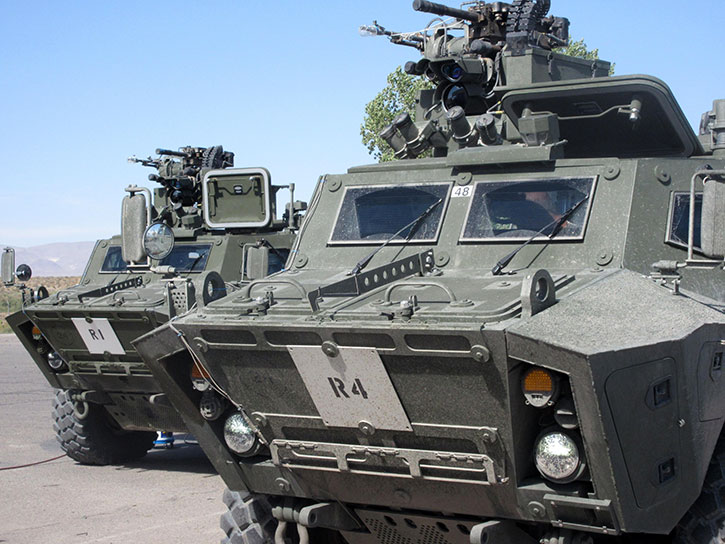
TAPV The Canadian Armed Forces (CAF) took delivery of the first six Tactical Armored Patrol Vehicles (TAPV) earlier in August. TAPV is a beefed-up variant of Textron Systems’ ‘Commando Elite’ 4×4 mine-protected armored vehicle, specially designed to address the Canada’s requirement for a replacement for the 8×8 Coyote armored recce vehicle and 4×4 RG-31 Mk3 Nyala armored utility vehicles.
The new vehicle is more powerful and better protected than its predecessors; powered by a 365 hp Cummins QSL365 diesel engine and Allison Transmission 3200SP automatic transmission the 18.6-ton vehicle sustains a top road speed of 105 km/h, it’s internal fuel sustains an operational range of 644 km. Despite its weight TAPV is sized for air-mobility – Four TAPVs can be transported simultaneously by a CC-177 Globemaster III (The Canadian designation for the Boeing C-17), providing the strategic mobility supporting contingency operations far from the homeland.
The vehicle has fully independent front and rear suspension. The wheels use Michelin 16.00R20 XZL tires with run flat inserts from Hutchinson. A spare tire is also carried on the rooftop.
Each TAPV has an integral weapon station, enabling the crew to observe and fire without exposing themselves to enemy fire. The RWS selected by the Canadians is the Protector DRWS (Dual Remote Weapon Station) from Kongsberg Protech Systems The weapon station mounts two weapons – an FN Herstal 7.62mm C6 light machine gun, 40mm Heckler & Koch GMG automatic grenade launcher and smoke grenade launchers, used mainly for self-protection. The weapon station has an integral optronic system enabling the operator to see at distances of up to 10,000 meters. The vehicle also has front and rear cameras.
The survivability system comprises a base armor and appliqué armor package designed by IBD Deisenroth Engineering and its local subsidiary EODC (Engineering Office Deisenroth Canada); the armor package shields troops from ballistics and roadside blasts (IED). Other survivability and protection features include laser warning system, wire cutter mounted in front and NBC protection system. The vehicle has four elevated mounts for antennae, providing reduced interference between multiple electronic emitters such as radios, datalinks, navigation systems, and jammers.
The vehicle also has a climate control system and high capacity alternator keep the internal space cool, provides electricity to support onboard electronic systems and provide large power reserves for future electronics enhancements.
The order includes 300 general utility variants and 200 recce vehicles. The only differences between variants are their internal design and certain pieces of equipment. The Reconnaissance variant will be fielded to armored reconnaissance squadrons, infantry reconnaissance platoons and the Royal Canadian Armored Corps School. The TAPV fleet will be distributed across multiple locations throughout Canada, supporting the 2nd, 3rd, 4th and 5th Canadian Divisions in combat, combat support and training roles.
Other advanced systems include health and usage monitoring system, ensuring a high level of readiness and optimize lifecycle management.
In 2012 Textron won the contract worth CA$603.4 to deliver 500 TAPVs, with options to supply 100 more. Textron Systems plans to deliver at least 30 vehicles per month to the Canadian Army with all vehicles scheduled to be delivered by December 2017. The 2nd Canadian Division will be the first formation to operate the TAPV, which will be part of a High Readiness Training Cycle culminating in Exercise MAPLE RESOLVE 2018. The Canadian Army expects to declare full operational capability by mid-2020 with a fleet of 500 vehicles, distributed to 24 units across seven bases.




















